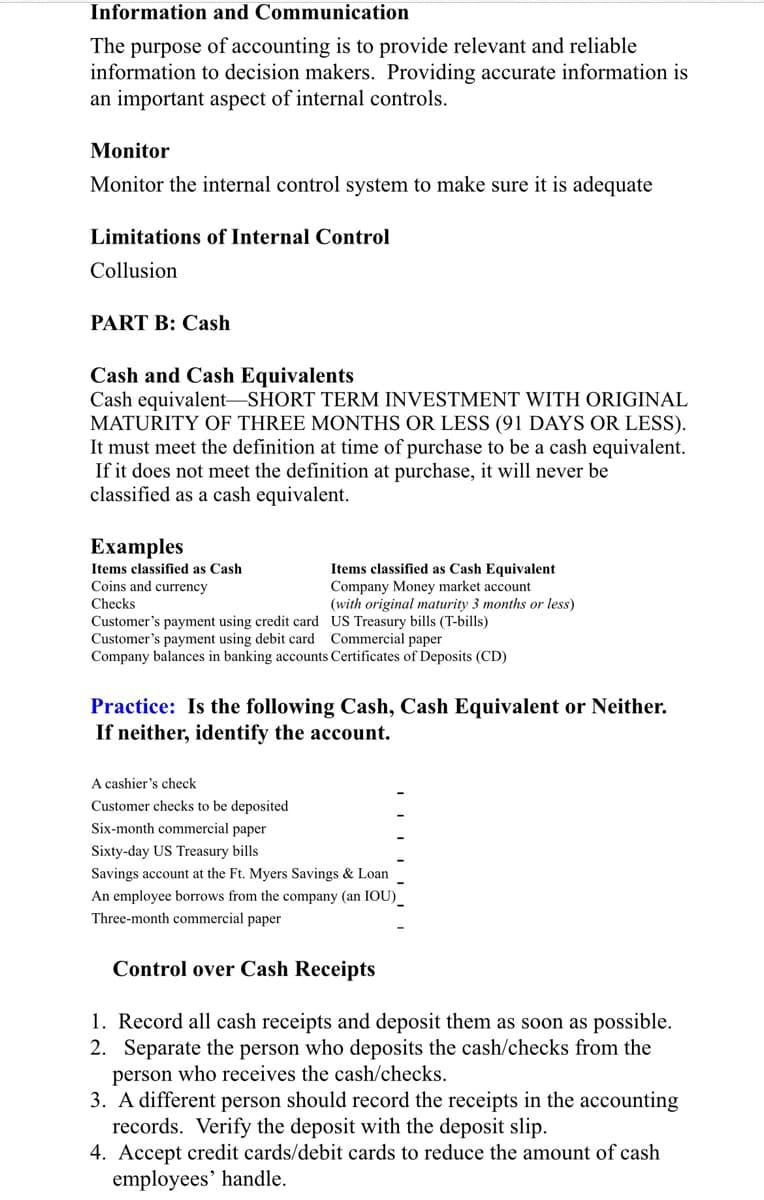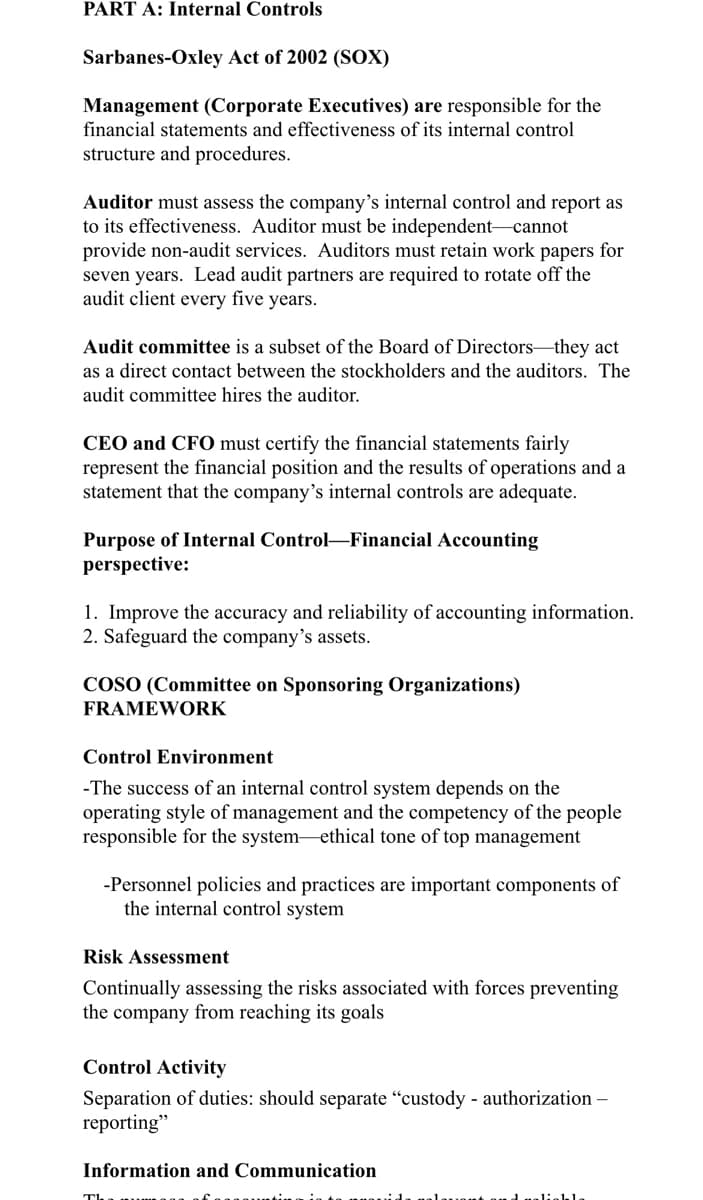From pages 4-1 and 4-2 of the VLN, the COSO Framework describes 5 components of internal control. What is the purpose of internal controls from a financial accounting perspective? 1. To guarantee no fraud will occur in the organization. 2. To help safeguard the company's assets. 3. To help improve the accuracy and reliability of the accounting information. 4.To prevent collusion. Group of answer choices A. 1,2, and 3 B. 2 and 3 C. 2, 3, and 4 D.1, 2, 3, and 4
From pages 4-1 and 4-2 of the VLN, the COSO Framework describes 5 components of internal control. What is the purpose of internal controls from a financial accounting perspective? 1. To guarantee no fraud will occur in the organization. 2. To help safeguard the company's assets. 3. To help improve the accuracy and reliability of the accounting information. 4.To prevent collusion. Group of answer choices A. 1,2, and 3 B. 2 and 3 C. 2, 3, and 4 D.1, 2, 3, and 4
Financial Accounting: The Impact on Decision Makers
10th Edition
ISBN:9781305654174
Author:Gary A. Porter, Curtis L. Norton
Publisher:Gary A. Porter, Curtis L. Norton
Chapter1: Accounting As A Form Of Communication
Section: Chapter Questions
Problem 1.7DC
Related questions
Question
From pages 4-1 and 4-2 of the VLN, the COSO Framework describes 5 components of internal control. What is the purpose of internal controls from a financial accounting perspective?
1. To guarantee no fraud will occur in the organization.
2. To help safeguard the company's assets.
3. To help improve the accuracy and reliability of the accounting information.
4.To prevent collusion.
Group of answer choices
A. 1,2, and 3
B. 2 and 3
C. 2, 3, and 4
D.1, 2, 3, and 4

Transcribed Image Text:Information and Communication
The purpose of accounting is to provide relevant and reliable
information to decision makers. Providing accurate information is
an important aspect of internal controls.
Monitor
Monitor the internal control system to make sure it is adequate
Limitations of Internal Control
Collusion
PART B: Cash
Cash and Cash Equivalents
Cash equivalent-SHORT TERM INVESTMENT WITH ORIGINAL
MATURITY OF THREE MONTHS OR LESS (91 DAYS OR LESS).
It must meet the definition at time of purchase to be a cash equivalent.
If it does not meet the definition at purchase, it will never be
classified as a cash equivalent.
Examples
Items classified as Cash
Coins and currency
Items classified as Cash Equivalent
Company Money market account
(with original maturity 3 months or less)
Checks
Customer's payment using credit card US Treasury bills (T-bills)
Customer's payment using debit card Commercial paper
Company balances in banking accounts Certificates of Deposits (CD)
Practice: Is the following Cash, Cash Equivalent or Neither.
If neither, identify the account.
A cashier's check
Customer checks to be deposited
Six-month commercial paper
Sixty-day US Treasury bills
ngs
at the Ft. Myers Savings & Loan
An employee borrows from the company (an IOU)
Three-month commercial paper
Control over Cash Receipts
1. Record all cash receipts and deposit them as soon as possible.
2. Separate the person who deposits the cash/checks from the
person who receives the cash/checks.
3. A different person should record the receipts in the accounting
records. Verify the deposit with the deposit slip.
4. Accept credit cards/debit cards to reduce the amount of cash
employees' handle.

Transcribed Image Text:PART A: Internal Controls
Sarbanes-Oxley Act of 2002 (SOX)
Management (Corporate Executives) are responsible for the
financial statements and effectiveness of its internal control
structure and procedures.
Auditor must assess the company's internal control and report as
to its effectiveness. Auditor must be independent-cannot
provide non-audit services. Auditors must retain work papers for
seven years. Lead audit partners are required to rotate off the
audit client every five years.
Audit committee is a subset of the Board of Directors-they act
as a direct contact between the stockholders and the auditors. The
audit committee hires the auditor.
CEO and CF0 must certify the financial statements fairly
represent the financial position and the results of operations and a
statement that the company's internal controls are adequate.
Purpose of Internal Control-Financial Accounting
perspective:
1. Improve the accuracy and reliability of accounting information.
2. Safeguard the company's assets.
COSO (Committee on Sponsoring Organizations)
FRAMEWORK
Control Environment
-The success of an internal control system depends on the
operating style of management and the competency of the people
responsible for the system-ethical tone of top management
-Personnel policies and practices are important components of
the internal control system
Risk Assessment
Continually assessing the risks associated with forces preventing
the company from reaching its goals
Control Activity
Separation of duties: should separate “custody - authorization –
reporting"
Information and Communication
Tha
uont and ualiekle
Expert Solution
This question has been solved!
Explore an expertly crafted, step-by-step solution for a thorough understanding of key concepts.
This is a popular solution!
Trending now
This is a popular solution!
Step by step
Solved in 2 steps

Knowledge Booster
Learn more about
Need a deep-dive on the concept behind this application? Look no further. Learn more about this topic, accounting and related others by exploring similar questions and additional content below.Recommended textbooks for you

Financial Accounting: The Impact on Decision Make…
Accounting
ISBN:
9781305654174
Author:
Gary A. Porter, Curtis L. Norton
Publisher:
Cengage Learning

Auditing: A Risk Based-Approach (MindTap Course L…
Accounting
ISBN:
9781337619455
Author:
Karla M Johnstone, Audrey A. Gramling, Larry E. Rittenberg
Publisher:
Cengage Learning

Managerial Accounting
Accounting
ISBN:
9781337912020
Author:
Carl Warren, Ph.d. Cma William B. Tayler
Publisher:
South-Western College Pub

Financial Accounting: The Impact on Decision Make…
Accounting
ISBN:
9781305654174
Author:
Gary A. Porter, Curtis L. Norton
Publisher:
Cengage Learning

Auditing: A Risk Based-Approach (MindTap Course L…
Accounting
ISBN:
9781337619455
Author:
Karla M Johnstone, Audrey A. Gramling, Larry E. Rittenberg
Publisher:
Cengage Learning

Managerial Accounting
Accounting
ISBN:
9781337912020
Author:
Carl Warren, Ph.d. Cma William B. Tayler
Publisher:
South-Western College Pub

Auditing: A Risk Based-Approach to Conducting a Q…
Accounting
ISBN:
9781305080577
Author:
Karla M Johnstone, Audrey A. Gramling, Larry E. Rittenberg
Publisher:
South-Western College Pub

Principles of Accounting Volume 1
Accounting
ISBN:
9781947172685
Author:
OpenStax
Publisher:
OpenStax College

Accounting Information Systems
Accounting
ISBN:
9781337619202
Author:
Hall, James A.
Publisher:
Cengage Learning,